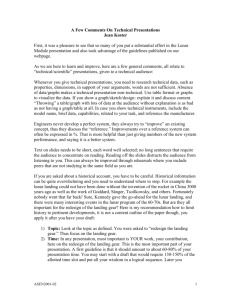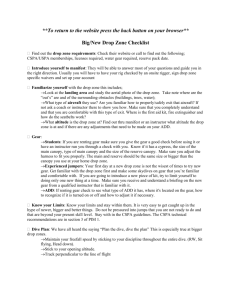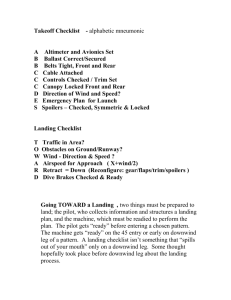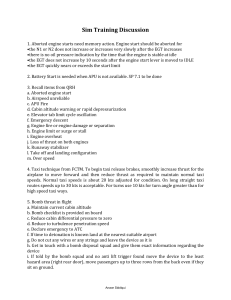to fly the airplane
advertisement
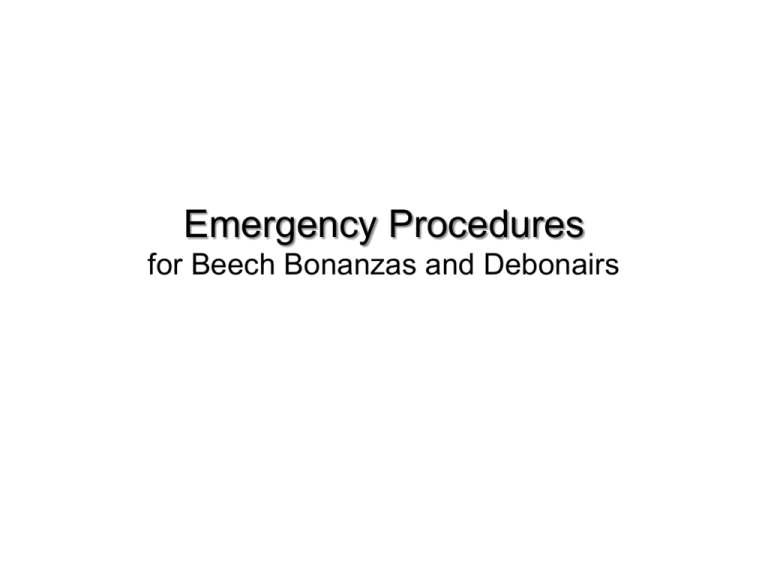
Emergency Procedures for Beech Bonanzas and Debonairs Single-Engine Emergencies • Stimulate thought and visualization • Avoid confusion and panic • Thinking through emergency scenarios ahead of time • Reinforce knowledge of aircraft systems and procedures Two Types of “Emergencies” • Abnormal conditions • True emergencies Two Types of “Emergencies” True emergencies • Engine failures • Fires • Autopilot malfunctions • Split-flap condition • Door open on takeoff 1. Cabin door unlatches 2. Manual landing gear extension 3. Electrical system failure 4. Engine power loss/forced landing Priority of Actions • • • • Maintain aircraft control Analyze the situation Continue to control the aircraft Take the appropriate action Door Open on Takeoff Door Open in Cruise Flight • Maintain aircraft control • Land to secure the door • Added drag, added fuel to destination • Pattern considerations • CHECK LANDING GEAR! Landing Gear Malfunctions Possibilities: • Landing gear motor failure • Manual gear hand crank obstruction • Bent or broken gear system push rod or rod end Landing Gear Malfunction Do’s and Don’ts • Do NOT cycle the gear • DO climb to a safe altitude • DO use the POH Emergency checklist BANG! • Reference the Landing Gear Manual Extension checklist • Perform all steps to beginning the crank • Turn the hand crank onehalf to three-quarters of a turn • Stow the hand crank and reset the breaker If the gear will not extend, start the checklist over and extend the landing gear fully by hand. Manual Extension Technique • • • • • Follow the checklist! Slow the airplane to 100 – 110 knots Turn the hand crank approximately 15 turns Sit up, confirm attitude, look for traffic Add 1 to 2” MP Manual Extension: a Technique Repeat the technique: • Crank 15 turns • Confirm attitude • Look for traffic • Add 1 to 2” MP Then: • Crank 10 turns (it will get harder) • Confirm attitude • Look for traffic • Add 1 to 2” MP And finally: • Crank 10 turns or until it will go no further • Confirm attitude • Look for traffic • Add 1 to 2” MP • Avionics begin to dim • NAV flag on HSI or OBS • Odd odor Electrical Fire What do you lose? • • • • • • Turn coordinator HSI Electric attitude indicator Autopilot Communications and navigation Engine gauges and fuel indicators Now what? • • • • • • • Ventilate the cabin Fire extinguisher Emergency descent Land as soon as possible Turn on only what you absolutely need Gear extension No-flap landing Night/IMC • Flashlights • Handheld comm radio with external antenna • Handheld GPS • Land as soon as practical • Fly toward improving weather Engine Failures Consider… Propeller Overspeed • Throttle – RETARD TO PROPELLER RED LINE • Airspeed – REDUCE • Oil Pressure – CHECK • Land – NEAREST SUITABLE SITE Priority of Actions • Maintain control of the airplane • Analyze the situation • Take corrective actions Total NTSB Reports and Engine Failures 700 600 500 400 Reports 300 Engine Fail 200 100 0 1980s 1990s 2000s Engine Failures and Fuel 450 400 350 300 250 Engine Failure Fuel Related 200 150 100 50 0 1980s 1990s 2000s Other Engine Failure Causes • Mechanical failures (cylinders, propellers, etc.) • Maintenance issues in the fuel system • Ignition and oil systems • Undetermined Who owns the airplane? THE INSURANCE COMPANY What is your job? CONTINUE TO FLY THE AIRPLANE Pilot Action Plan • Maintain control of the airplane • Aim for an emergency landing site • Perform the memory steps of the Engine Failure in Flight checklist • Attempt to restart the engine • Maximum Glide configuration • Landing Without Power checklist • Passenger evacuation • Contact help and ATC Best Glide • PITCH for Best Glide – 105 to 110 knots for most; as low as 90 mph in some – Reduces with airplane weight – 6 degrees nose low attitude • Gear and Flaps: UP • Propeller: PULL FULLY AFT • TRIM Pilot Action Plan • Maintain glide speed and attitude • Switch to a MAIN fuel tank you know contains fuel • Aim for an emergency landing site Attempt a Restart If time and altitude permit: • • • • Verify the fuel selector valve Mixture control Auxiliary fuel pump Alternate air handle (when equipped) Forced Landing • • • • • • • • • • Continue to your landing site MAYDAY call if time permits Fuel selector OFF Mixture control IDLE CUTOFF Magnetos OFF Brief your passengers Tighten seat belts and shoulder harnesses Flaps and landing gear Battery and Alternator/Generator OFF Fly until the airplane stops moving How far can I glide? What rate of descent should I expect? Radius of glide Straight-in key Base key 1000 ft AGL 800 ft AGL High key 2500 ft AGL Downwind key 1500 ft AGL Touchdown • Aim about 1/3 of the way into your landing zone • Land with as little energy as possible Touchdown Considerations • • • • Seat belts and shoulder harnesses Touch down aligned with the landing surface Extend the landing gear Fuel and electrical switches OFF Touchdown Considerations • Wings level • Nose up “Fly the thing as far into the crash as possible” – Bob Hoover Physics at Touchdown KINETIC ENERGY = ½ mass x (velocity squared) - all this has to be dissipated somewhere at impact Example--weight 3000 pounds Touchdown GS (kts) KE (ft-lbs) % change Normal (65 kts) 562,128 0 Downwind (80 kts) 851,508 +52% Into the wind (50 kts) 332,620 -41% Impact G-Forces Speed (kts) Minimum distance for 9Gs Gs per 1 ft of travel G per 50 ft of travel G per 100 ft of travel 50 12 111 2.2 1.1 65 21 188 3.75 1.9 80 32 234 5.7 2.9 100 49 443 8.9 4.4 Seat belt design strength is about 9Gs Engine Failure on Takeoff • Expect the engine to fail every time • Mentally review your Action Plan just before you line up • Climb at full power and Vy to at least 1000 feet AGL • More altitude = more options • • • • • • • • • Maintain control of the airplane Push for airspeed Aim for your pre-planned emergency field Switch tanks Auxiliary fuel pump Maintain control Flaps DOWN Landing gear DOWN Fuel and electrical OFF FIRE! FIRE! • • • • • Memorized checklist Mixture: IDLE CUTOFF Fuel selector: OFF Transition to Maximum Glide Emergency Descent One more time… • • • • Maintain aircraft control Analyze the situation Continue to control the aircraft Take the appropriate action Complete your training and fly with the Beech experts! See www.bppp.org Especially For

